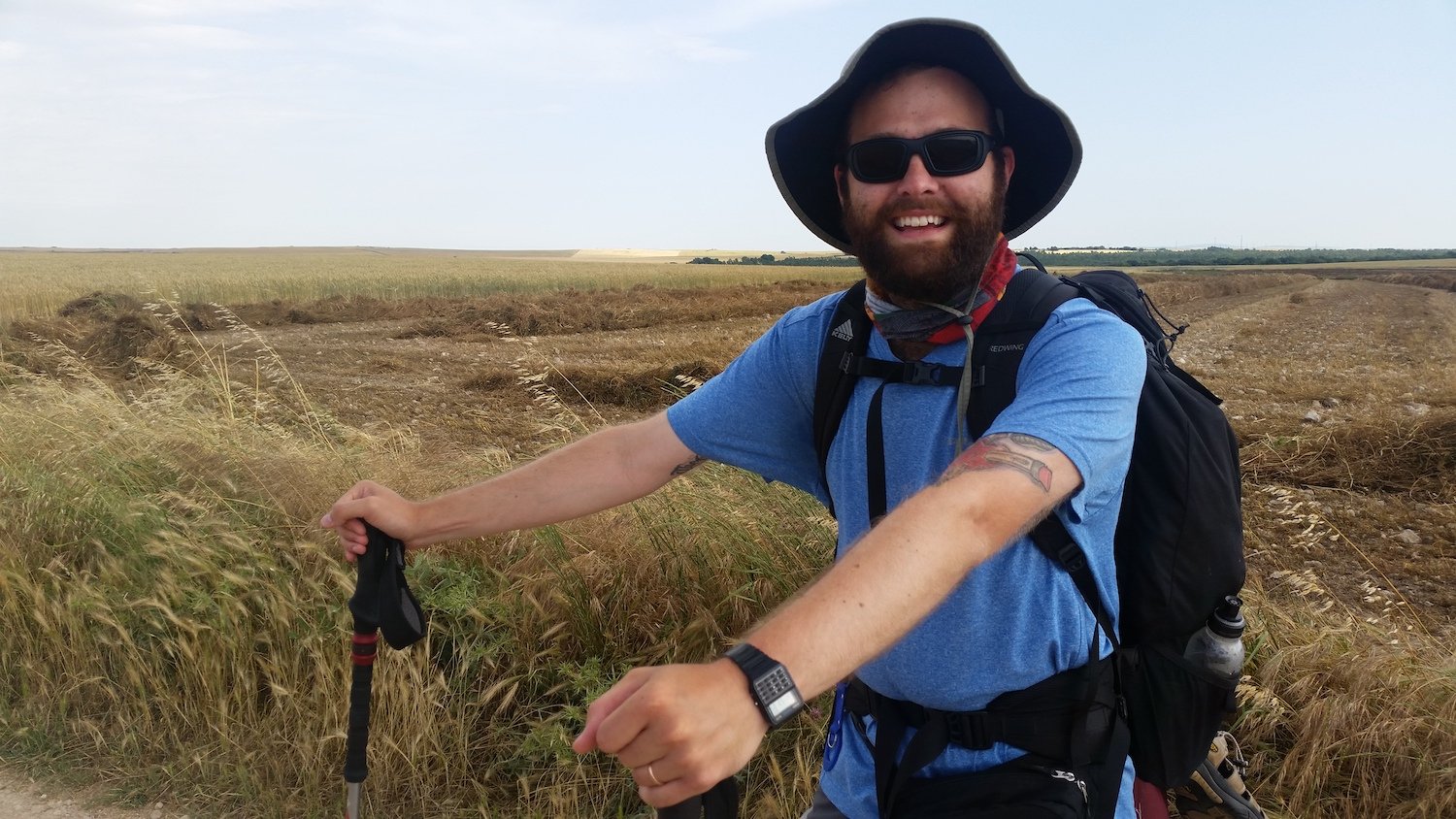Spain’s geographical heart is large and flat and has two chambers. The two chambers are rimmed by mountains, more or less, with the Systema Centra acting as a wall between them. Both chambers (North and South) carry the name Meseta. The name translates into English as a “plateau,” “tableland,” or “highland.”
The Spanish Meseta is a vast treeless plain with freezing winters and warm summers.*
The inhabitants of the Meseta are characterized as tough and sober and touched with mystic madness. The most famous of these is Don Quixote, a literary invention, of course (although I found his eyes in stores and churches and cafés and am convinced that bits of him are real). Other Meseta inhabitants worth mentioning include St John of the Cross, St Teresa of Ávila, and the author-poet Francisco Pino. These four examples are outliers, no doubt, but they speak to the ardor of the region.
Rational peregrinos skip this backstretch of the Camino Francés (or at least catch a bus in Burgos and trundle across to the far side). Walkers in previous generations didn’t have that option. Neither did this madman.
Bob and I walked out of Burgos and into the Meseta. Little did we know it would be the most painful segment of our adventure in Spain.
Bob is equipped.
At the edge of Burgos, the urban gravity offered us one last show of force. Asphalt highways and whisking cars formed barriers while curling ramps encouraged easy returns to the city.
We ignored these warnings and pressed into a world of soft earth and brittle grass. Cereal fields stretched as far as the eye could see.
In Tardajos we found breakfast. We also found old trail friends who shared our Meseta madness. The air was crisp that morning; some of them wore long sleeves, others, jackets. Would the day remain cool or go blazing? None of us had any idea.
After leaving Tardajos, the morning slowed and grew still.
The Meseta sky was pale blue, the kind of color that the sun-loving Greeks eventually found a word for: galazio (γαλάζιο).** That galazio expanse rose like a Greek dome overhead, from horizon to horizon. The sun crept across it; we walked under it. It was a journey for all that lacked hard reference points. We were the oddity, movement in an overexposed photograph. Bob and I did talk some, of the occasional bird or tree or chocolate bar or stone in the shoe. Such topics arise serendipitously when you tread a still landscape. But this was not a day for conversation. We retreated into zones of our own making.
The Meseta takes you to that kind of place. It strips away the noise and the distractions and the pain and reduces you to a single being, traveling lightly and effortlessly through the ether. Perhaps it is a product of the mechanics, a physical thing—moving arms and legs and lungs. I don’t know. But I do know I’ve been there before, mentally, on endurance runs, rides, and climbs. It is not a state to be feared nor welcomed but simply expected. This is, after all, the Camino experience. By definition, it should be meditative.
“And suddenly all the land was silent, mute and sombre,
meditating. Sound of the wind in the riverside poplars.”***
Ten miles rolled by, then fifteen. The sound of walking sticks against gravel was our only clock: tik-tik-tik.
We were released into a world of soft earth and brittle grass.
The zone was broken as we approached the río Hormazuela watershed. A loaded convoy of clouds forced themselves into galazio expanse, bringing on a premature twilight. What few trail mates we had disappeared completely.
A few sprinkles prompted a dive into the packs for rain gear and a guidebook consultation. A hostel appeared on the map, but when we got there, it had a creepy feel: a single building in a field with no other peregrinos about. I had a flashback to Grañón (see here). Bob may have had the same. We shook our heads pushed on.
We took a chance on Honatos. A light rain began to fall. Lighting flashed and thunder rolled. Closer and closer it came. The sprinkle turn to rain and then the front arrived. The wind tore at our rain gear and pack-covers. Raindrops turned to raingobs and then to pea-sized pellets.
The sky crackled and hail danced about our feet.
It was Kansas and I was 16 years old all over again.
“Run!” I shouted. Bob was already going.
We made for Honotos. Since the village crouched in a ravine, we didn’t know it was there until red roofs came out of the ground and we dropped down into them.
Winded, we descended to a collection of stone buildings. In the center was a church and an albergue. We burst through the door of the albergue to find a collection of wet pilgrims.
¡Buen Camino!
The village of Honotos, Spain (on the morning after the storm).
*Technically, the Meseta has a "cool dry-summer" climate (called Csb in the Köppen system). Areas of western Oregon and California in the United States share this classification.
**Ironically, the ancients struggled to express the color we call blue. It is fascinating to consider how language shapes color (or color shapes language)! Try this website as a starting point: https://www.iflscience.com/editors-blog/did-ancient-people-really-not-see-the-color-blue/ (accessed 2/12/2022).
***From the poem “Yo voy soñando caminas” by Antonia Machadao. Find the English translation at this website: https://www.poetryintranslation.com/PITBR/Spanish/Machado.php
We have a full slate of Bible Land trips ready to launch in 2022. Our first excursion after a two-year hiatus departs the USA at the end of March.
Check out a complete list by clicking here or browse BibleLandExplorer.com under the heading “Find your Trip.” For more information on how to join one of these trips or if you are interested in helping to craft a unique trip for your own group, church, or school, contact me at markziese@gmail.com.






